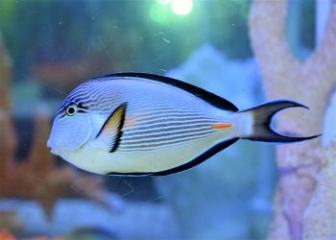Discus Fish - Learn about the queen of the aquarium in the most detailed way
Blog | by
Discus fish, a freshwater ornamental fish originating from South America, has a flat, slightly round body, diverse and colorful colors, and is very popular.
Discus fish (disc fish) has the scientific name Symphysodon, one of the most popular freshwater aquarium fish today thanks to its colorful, eye-catching appearance, round, lovely shape. They are also known as the "Queen of freshwater fish" and are chosen by many professional aquarium hobbyists.
If you want to learn more about the origin, habits, breeding techniques or the most popular discus fish species, please refer to the article below of nice fish!
Information about discus fish :
| Scientific name | Symphysodon |
| English name | Discussion |
| Common name | Discus, Angelfish |
| Branch | Chordata - Chordates |
| Class | Actinopterygii - Ray-finned fishes |
| Set | Perciformes - Sea bass |
| Surname | Cichlidae - Emperor fish, tilapia |
| Source | South America |
| Size | 15 - 20 cm |
| Lifespan | Average about 8 years. |
Origin of discus fish
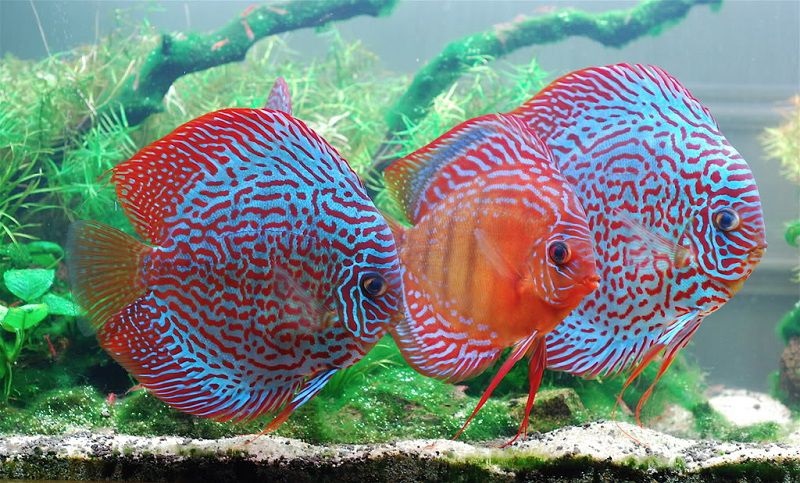
Discus fish are beautifully colored freshwater aquarium fish that come from South America.
Discus fish, also known as discus fish (scientific name Symphysodon, is a freshwater ornamental fish originating from the Amazon River basin in South America, especially the tributaries of Brazil, Peru and Colombia.
This fish lives mainly in slow-moving or still water areas, where there are many submerged plants, tree roots, rotten leaves, slightly acidic environments, and low light.
Since the 1930s, discus fish have been known in the high-end aquarium world, they have been bred with many colorful colors such as red, blue, dove, snakeskin, leopard skin,...
Some countries in the world are famous for breeding discus fish such as: Vietnam, Malaysia, Singapore,...
Classification of discus fish
Discus fish are divided into two main types based on origin and development characteristics: wild discus fish and purebred discus fish.
Wild discus fish
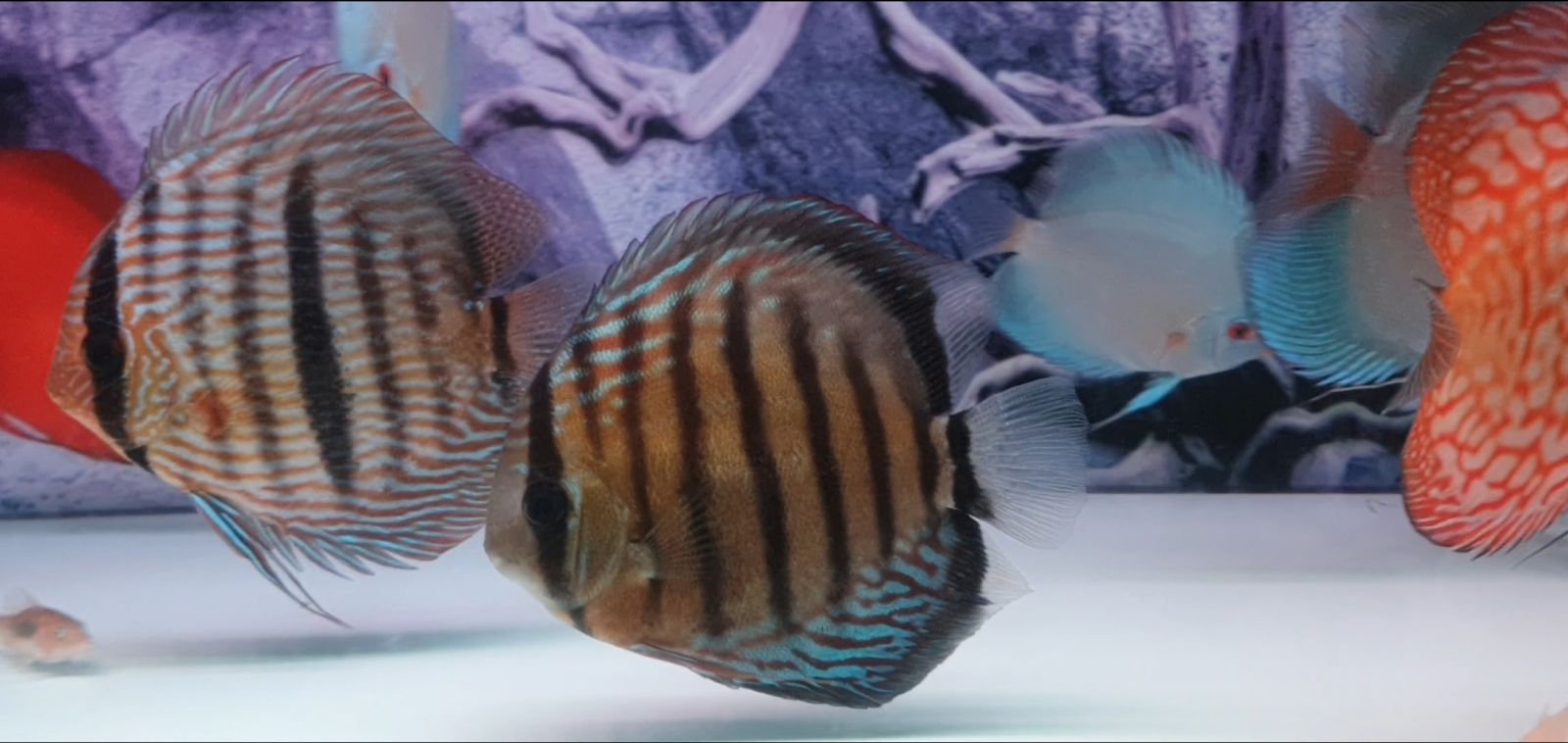
Wild discus with brown stripes.
A wild discus fish, caught directly from the rivers of the Amazon basin in South America. They have the following characteristics:
- The colors are not too rich, mainly blue, green, brown discus.
- Good health, but difficult to domesticate, high requirements for water quality.
- Shy temperament, difficult to keep with purebred discus fish.
Purebred discus fish
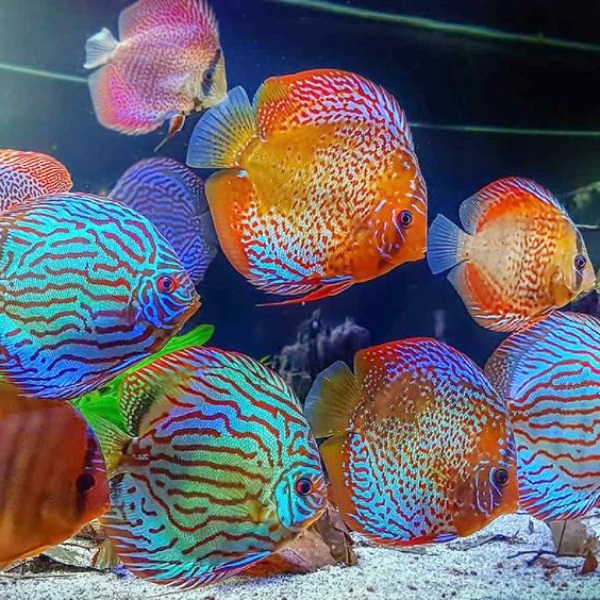
Purebred discus fish with many different colors.
As a type of discus fish bred in an artificial environment, they have the following characteristics:
- Easier to raise than wild fish because they have been domesticated and bred over time.
- Suitable for beginners.
- Many colorful colors such as: Red Melon, Blue Diamond, Snow White, Golden Albino....
Physical characteristics of discus fish

Discus fish come in many different colors and patterns.
Discus fish is a freshwater ornamental fish with a very beautiful appearance, in China it is even known as "Five-colored fairy". Let's learn more about the physical characteristics of this fish.
- Body shape : Flat, round like a plate, balanced body, when swimming they look like they glide lightly on the water surface.
- Size : Adult fish are 12 - 20 cm long, some hybrid lines can be up to 25 cm long.
- Eyes : Big, round eyes, usually red or yellow, look extremely alert.
- Dorsal & anal fins : Long, slightly curved along the body forming a curving ellipse.
- Pectoral & abdominal fins : Pectoral fins are transparent, pelvic fins are thin and long like threads.
- Tail : Round, small.
- Color : Diverse, depending on the breed, can be brown, green, blue, brick red, bright red, turquoise, albino, golden yellow, leopard skin, stripes, spots, wavy stripes,...
Discus fish behavior
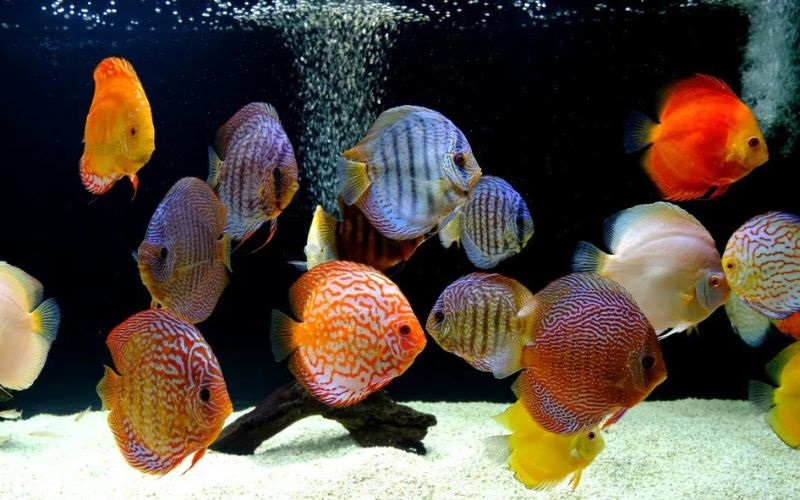
Discus fish like to live in schools.
Right below, we have shared details about the habits of discus fish, please learn more to be able to raise this fish better.
gentle, live in packs
Discus fish are quite docile, often attacked by other aggressive fish such as Betta fish (Siamese fighting fish), Red goldfish. Therefore, you should raise them with docile fish such as Neon Tetra fish , mouse fish ,...
This fish is also highly social, preferring to live in schools of 5-10 or more. If you keep them individually in small numbers, they will definitely be stressed, shy and like to hide.
There is hierarchy in the herd.
In a school or group there is always a dominant discus fish. They usually fight more aggressively for food, take up a good position in the tank and may even chase the weaker fish in the school.
Very picky eater
Discus fish are very picky eaters because they have a sensitive sense of smell. They only like to eat live food such as bloodworms, beef heart, mosquito larvae, they do not like to eat pellets but if given time to get used to it, they will adapt.
Slow to adapt, has strong reaction when stressed
Discus fish are quite sensitive to changes in the water environment such as temperature, pH, and water quality. They need a few days to get used to and adapt to the new tank.
When stressed by sudden changes in the environment, they may have reactions such as: darkening color, losing shine, pressing their bodies against the glass, breathing rapidly,...
Pairing up for reproduction
Discus fish will always pair up to reproduce, so you cannot force them to pair up at will. When reproducing, the male and female fish take turns caring for and protecting the eggs. After the fry hatch, they will suck the mucus on the body of the parent fish for the first 2-3 days. This is a very unique feature of this fish species.
Discus fish farming techniques from A to Z

Discus fish tank with full filtration, aeration and LED lighting system.
Below, we will guide you through the techniques of raising discus fish from A to Z for both new and experienced players to help keep the fish healthy and have beautiful colors. Let's find out now!
Prepare the tank to raise discus
To breed discus fish in a suitable living environment, you need to design the tank as follows:
- Volume : Minimum 80 - 130 liters for a school of 5 fish, length from 90 cm, height over 50 cm. If raising large numbers, a larger volume is needed to minimize disputes.
- Heater equipment : To maintain temperature from 28 - 30 degrees Celsius.
- Filter system : Use foam filter, overflow filter.
- Oxygenation : Continuously to increase dissolved oxygen.
- LED lights : Use soft light.
- Decoration : Plant aquatic plants, smooth gravel base, decorate with a cave,...
Ideal water parameters for discus fish
To help discus fish stay healthy, live long, and have beautiful colors, your water source needs to meet the following criteria.
- Temperature : Stable from 28 - 30 degrees Celsius.
- pH : 5.5 - 6.9
- Hardness : 1 - 5 dGH.
- Ammonia, Nitrite : 0 ppm.
- Change water : Change 20 - 30% of water every 2 - 3 days.
What do discus fish eat?
As shared above, discus fish are very picky eaters, so when feeding them you can choose some of the following foods:
- Minced beef heart.
- Bloodworms and larvae are thoroughly cleaned.
- Frozen Artemia.
- Special pellets for discus fish, but need to get used to it early.
Techniques for breeding discus fish
When they are adults, discus fish will pair up to breed, and when you see them pairing up, you need to do the following:
- Separate the male and female fish into a separate tank.
- Tape PVC pipes or bricks so the fish can lay eggs on them.
- After 48 - 60 hours of spawning, the baby fish will hatch. At first, you do not need to feed them anything because the baby fish will eat the mucus on the body of the parent fish. After 4 - 6 days, train them to eat newly hatched Artemia.
Common diseases in discus fish and how to treat them
When artificially raised, discus fish are often at risk of contracting some diseases such as fungus, fin rot, organ failure, bloating... Let's learn more about these diseases so that they can be treated promptly.
| Disease name | Symptom | How to handle |
| White mushroom | Fish have tiny white spots on fins, body, tail, scales,... |
Increase temperature to 31 - 32 degrees Celsius for 3 - 4 days to kill bacteria. Use diluted salt to bathe fish. Use antifungal and anti-fungal drugs specifically for ornamental fish. |
| fin rot | The fish's fins are torn, worn, and gradually rotten. The fish just lies on the bottom and is lazy to swim. |
Disinfect the tank, isolate sick fish. Use antibiotics for fish. |
| Organ failure | Fish are not agile, sluggish, stop eating, do not swim much |
Let the fish fast for 1 - 2 days. Add more vitamins to your food. Clean the tank, change the water. |
| Bloating | Abnormally swollen belly, fish has white stools |
Limit unsanitary raw foods. Bathe fish with diluted salt water. |
How much is the discus?
Currently, in the Vietnamese ornamental fish market, the price of discus fish often fluctuates depending on size, color and origin. Please refer to the details in the following price list:
| Discus fish | Reference price (VND/piece) |
| Mini discus fish size 6 - 8 cm | 130,000 - 160,000 VND/piece |
| Adult discus fish hand size | Over 500,000 VND/child |
| Beautiful color discus fish, mature | Over 300,000 VND/child |
| Standard, beautiful leopard discus fish | Over 600,000 VND/child |
Top 10 beautiful discus fish for aquarium
Currently, discus fish have many different color and pattern variations. Let's learn about 10 beautiful and popular discus fish in the Vietnamese ornamental fish market today.
Blue Discus Fish
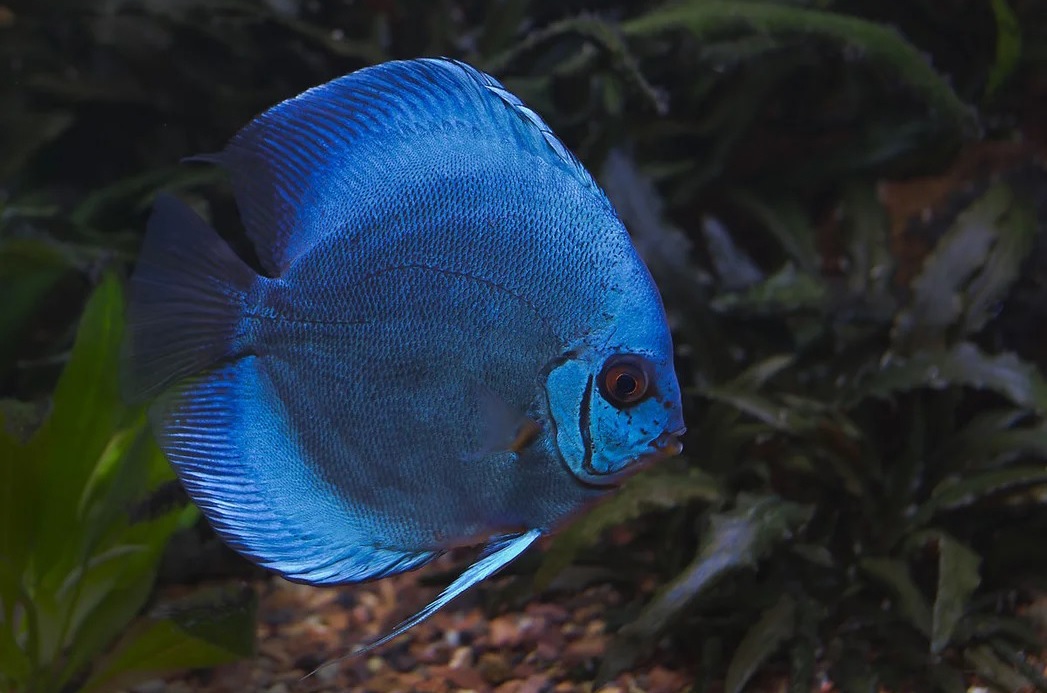
A special blue discus fish.
One of the most popular discus fish because of its soft, attractive colors with blue or turquoise bodies, some individuals have horizontal or vertical stripes. They are often kept with red, white or yellow discus fish to create a color contrast in the tank.
Brown Discus
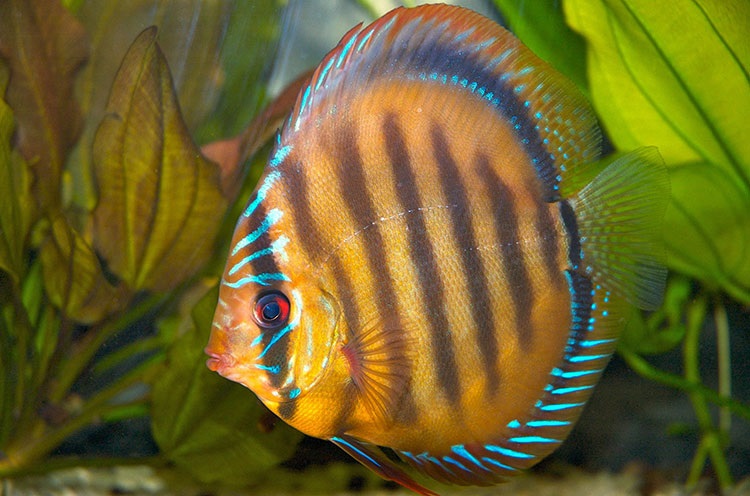
Wild brown discus with striking colors.
This is the original wild discus fish, commonly found in the Amazon River basin in South America. They are not brightly colored but have a very rustic brown color, combined with 9 black stripes running along the body, amwts are usually orange or brick red and average size is only 12 - 15 cm.
Red Discus - Red Discus
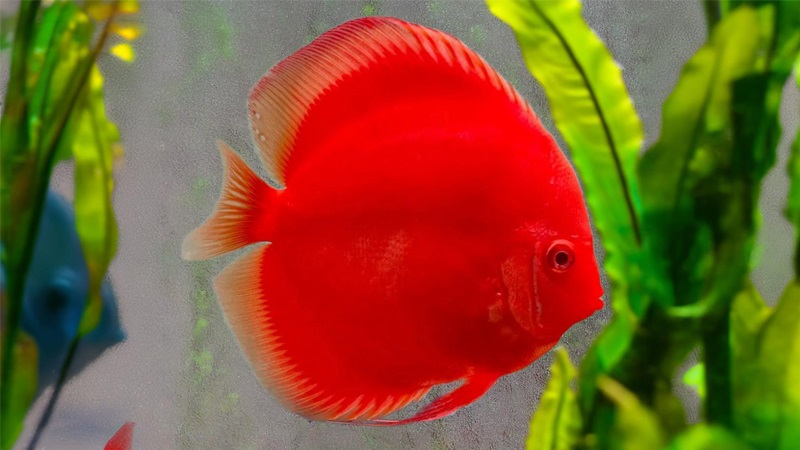
Red discus with brilliant colors.
This is one of the most popular discus fish in the aquarium world because of its extremely eye-catching colors. The entire body is orange-red, brick red or bright red, some species have fine veins or mesh patterns, creating a perfect highlight in the aquarium.
Golden Discus
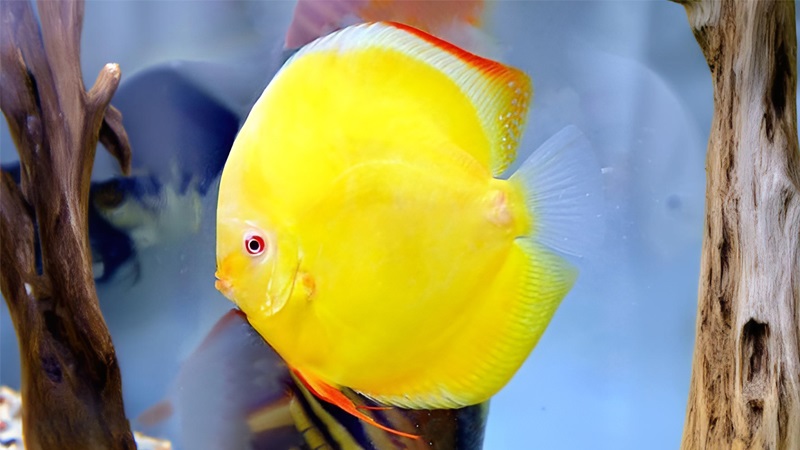
A discus fish with a bright yellow color.
Besides red discus, yellow discus is also very popular in aquariums because its body has a very bright lemon yellow, metallic yellow or cream yellow color, especially under LED lights. In this line, they usually do not have stripes or extremely fine veins.
Pigeon Blood Discus
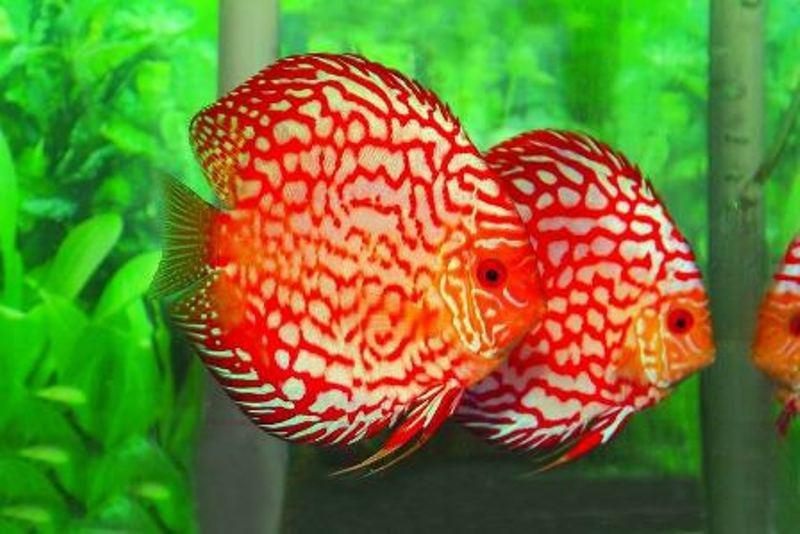
A pair of pigeon discus fish.
This is considered the "Queen of patterns" of the discus line. They have also been bred for a long time and are very popular in the aquarium world. Their bodies have brilliant colors with bright white, light yellow cream combined with red veins, red polka dots, and prominent red blood spots.
Leopard Ring Discus
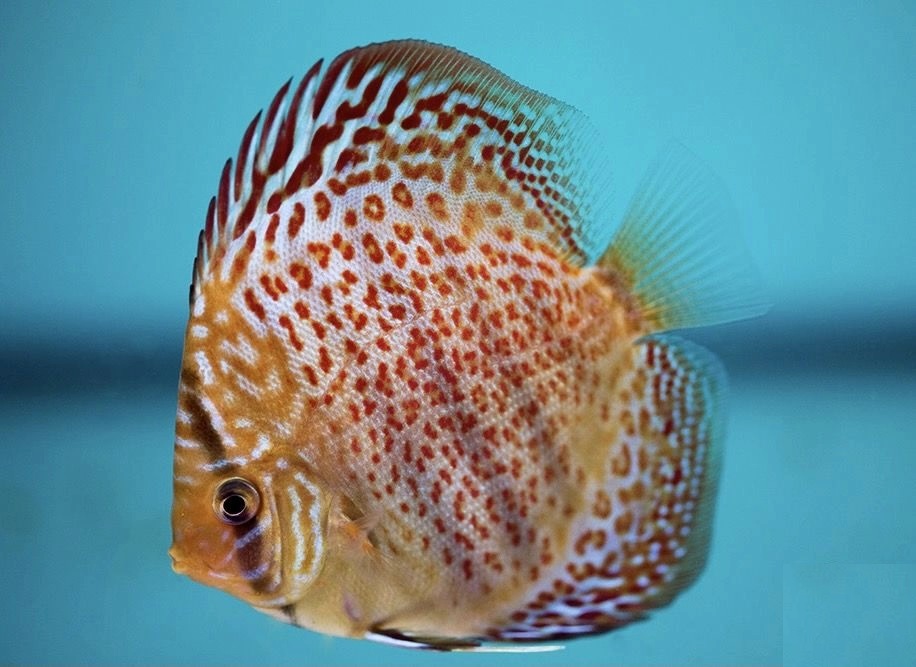
Leopard discus with unique pattern.
This is the most popular discus variant with small red spots on the male like leopard skin standing out on the milky white, pale yellow or cream body. Their eyes are usually red or orange, the size of the adult fish is from 12 - 18 cm.
Snow White Discus Fish
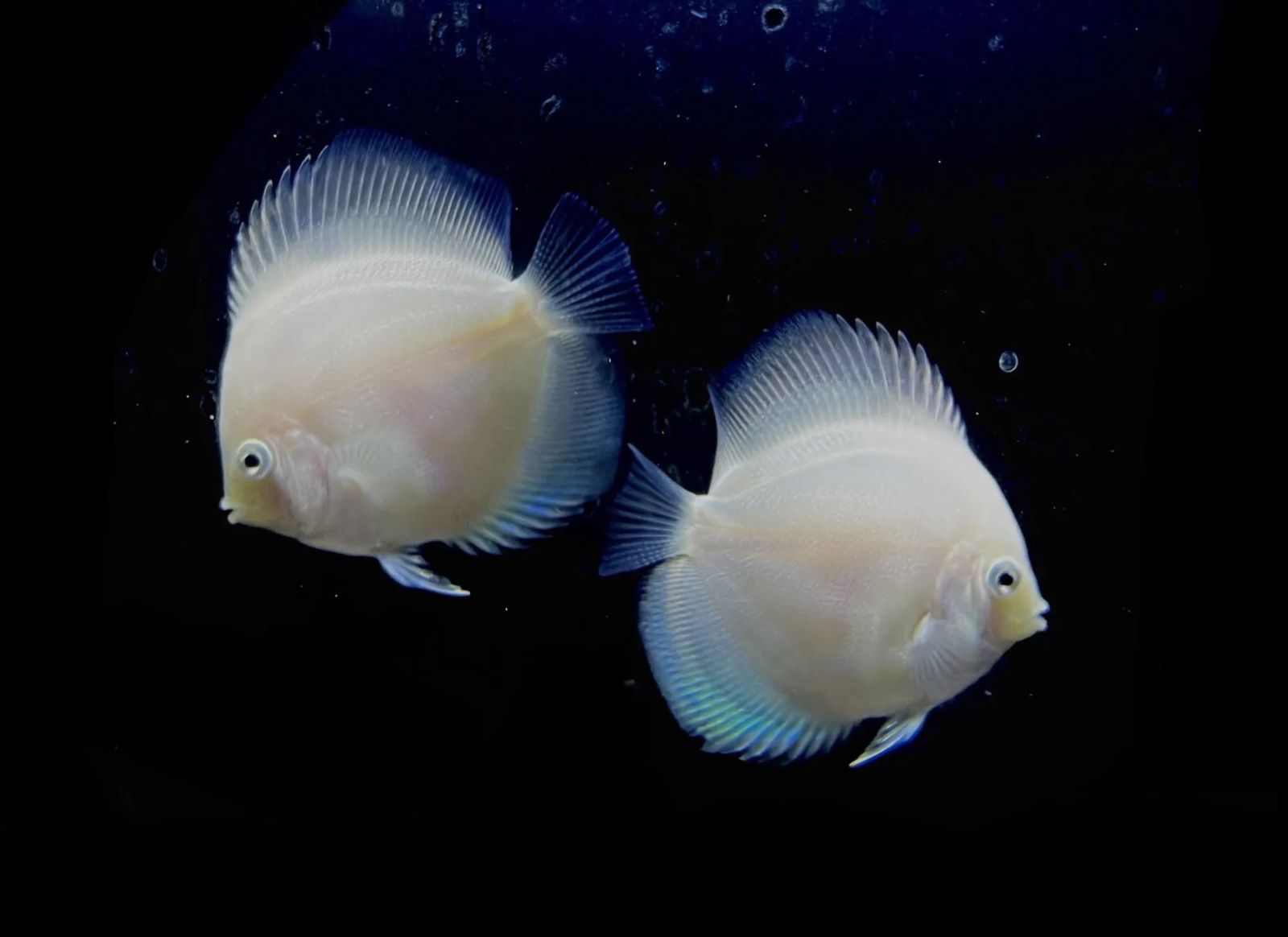
A pair of show white discus.
This is a type of discus fish that is loved by many aquarium hobbyists because it has a pure white color, no stripes, no stripes, extremely pure and outstanding under the light.
Rose Discus
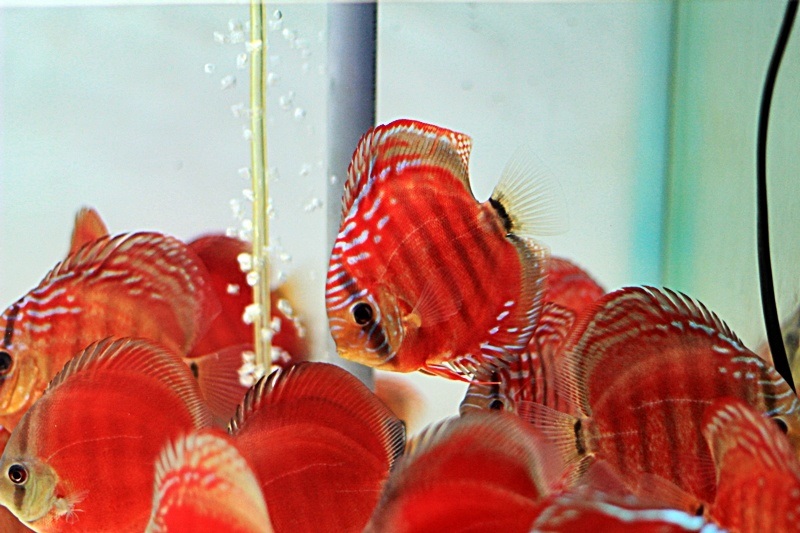
A colorful rose discus tank.
Rose discus is a type of discus with the most brilliant and eye-catching colors. They are likened to beautiful red roses with bright red or dark pink colors, combined with black striped fish or fish without stripes, with red or orange eyes that stand out under the light.
Galaxy Discus
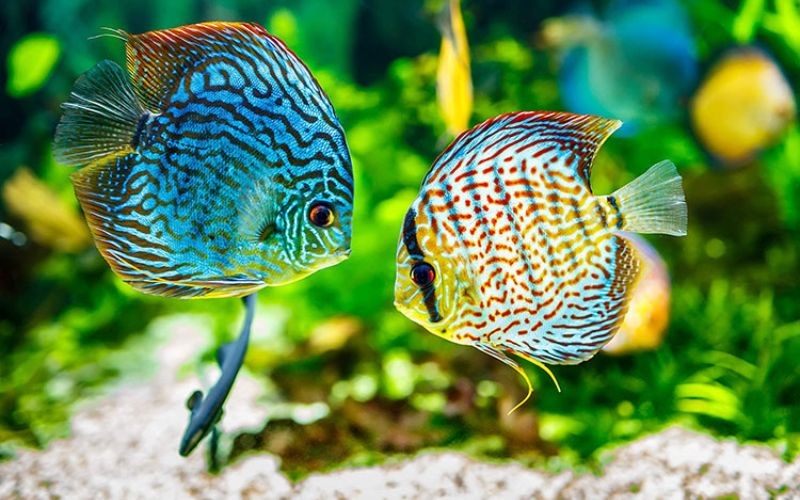
Galaxy discus fish.
Galaxy discus fish are very valuable and sought after by aquarium hobbyists because of their outstanding appearance with impressive patterns and colors like a starry sky. The background color is mainly dark purple, reddish brown, with tiny white spots combined with streaks like the Milky Way.
Through the above article, nicefish.net has shared with you detailed information about discus fish . This is indeed a beautiful ornamental fish, with the most eye-catching colors, quite easy to raise and has many interesting habits. If you want your aquarium to look more lively and attractive, discus fish is a great choice.
Don't forget to visit our Blog section to learn more about other beautiful and interesting aquarium fish. Goodbye and see you soon!
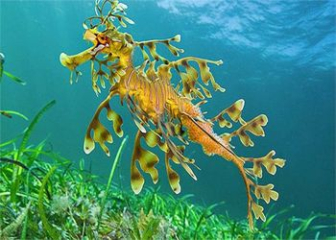
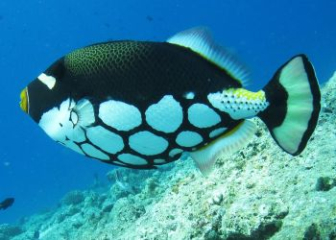
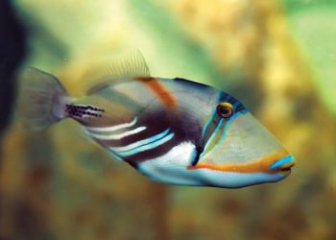
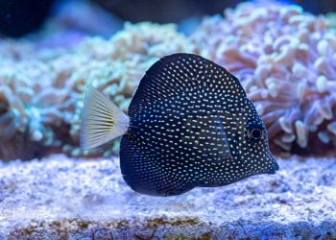
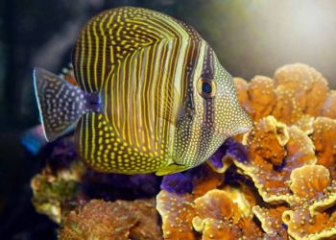
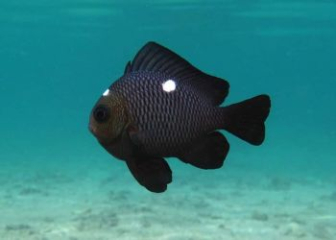
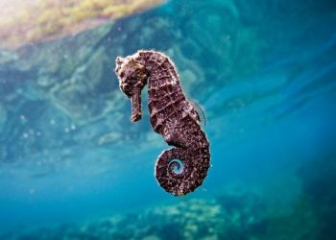






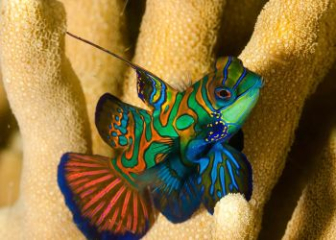

_350x250.jpg)


